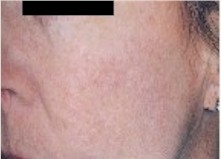VASCULAR LESIONS
 Before |
 After |
Facial Spider Veins, or Telangiectasia, are one of the most common facial skin conditions for which patients seek treatment. These unsightly dilated blood vessels are seen almost exclusively in patients with fair skin, and are often associated with chronic sun exposure, rosacea, overuse of cortisone creams and certain autoimmune diseases, and occasionally they may be hereditary. In many cases, the exact cause is unknown.
 Before LuxG Treatment |
 1 Month After |
The absorption of pulsed light in oxyhemoglobin, de-oxyhemoglobin, and the resultant thermal action inside the blood vessels result in intraluminal coagulation, vasoconstriction, and damage to the vessel endothelial lining, all of which contribute to the degeneration and disappearance of any visible vessels.
Leg Veins
The venous system of the legs is divided anatomically between superficial veins and the deep venous system (femoral veins). The job of the superficial venous system is pumping blood to the deep venous system. The deep venous system pumps blood up the leg into the pelvis and back to the heart.
In the standing or reclining position the venous blood is pumped into the deep vein system (femoral vein) of the legs from the lower leg, thigh and into the pelvis. If you are lying down with your feet up gravity becomes the force to allow venous blood to flow into the deep venous system along the entire leg back to the heart. In the standing position the venous blood is actively pumped up the veins in the leg. This is achieved when your leg muscles squeeze the superficial and deep venous systems.
When the muscles relax, the venous blood rushes back down the leg veins. To prevent this from happening the venous valves in the vein close during sitting and standing when the leg muscles relax. This is supposed to prevent vein blood from flowing backwards down the vein. Venous valves do not close allowing blood to leak back down the vein. Over time this will cause the wall of the veins to bulge, resulting in varicose and spider veins. There is no definitive reason as to why this happens. It can be a “Family trait”, prolonged standing/sitting, or incomplete recovery after an injury. But it can also be a symptom of an underlying disease such as arteriole sclerosis
For best results a proper diagnosis and treatment of any underlying causes by a qualified physician is recommended.
These can now be treated in our office with a laser and/or Sclerotherapy
Sclerotherapy
Sclerotherapy is a medical procedure conducted on unsightly veins. This procedure destroys the vein and causes the vein to gradually fade away over time when injected with safe solutions such as saline.
Handpieces that perform Vascular Lesion Treatment:
LuxG™
Lux1064™